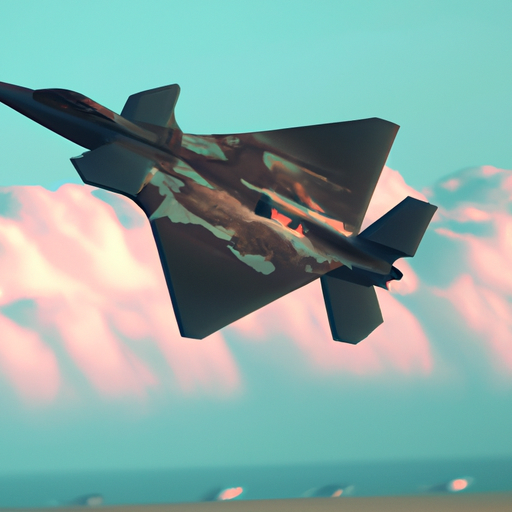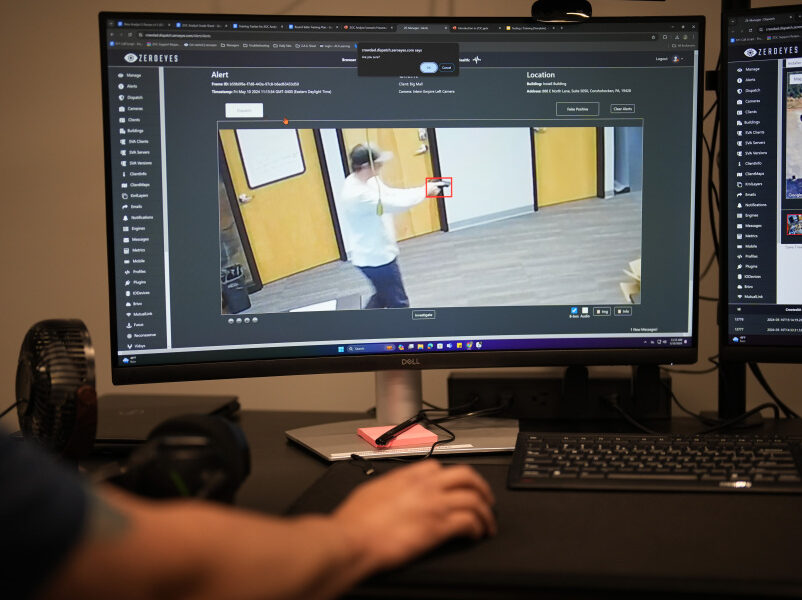The United States Air Force (USAF) is leveraging artificial intelligence (AI) to enhance the performance of its fighter jets. AI is being used to improve the accuracy of the aircraft’s sensors, the speed of its decision-making, and the effectiveness of its weapons systems.
AI-enabled sensors are being used to detect and identify objects in the air and on the ground more quickly and accurately. This allows the aircraft to respond to threats faster and more effectively. AI-enabled sensors can also detect and identify objects in the air and on the ground that are too small or too far away for human pilots to detect.
AI is also being used to improve the speed of decision-making. AI-enabled systems can process data faster than humans, allowing pilots to make decisions more quickly and accurately. This can be especially useful in high-stress situations, such as dogfights or air-to-air combat.
Finally, AI is being used to improve the effectiveness of weapons systems. AI-enabled systems can analyze data from multiple sources and identify targets more quickly and accurately. This allows pilots to launch weapons more quickly and accurately, increasing the chances of a successful mission.
The USAF is leveraging AI to enhance the performance of its fighter jets, improving the accuracy of its sensors, the speed of its decision-making, and the effectiveness of its weapons systems. This will allow the USAF to remain at the forefront of air combat technology and ensure its pilots are well-equipped to face any challenge.
The Benefits of AI-Piloted Fighter Jets for the US Air Force
The United States Air Force (USAF) stands to benefit greatly from the introduction of Artificial Intelligence (AI)-piloted fighter jets. AI-piloted fighter jets are capable of performing complex maneuvers and reacting to changing conditions in the air with greater speed and accuracy than human pilots. This technology has the potential to revolutionize the way the USAF conducts air operations, providing a number of advantages over traditional manned aircraft.
One of the primary benefits of AI-piloted fighter jets is their ability to fly with greater precision and accuracy than human pilots. AI-piloted aircraft are able to process and analyze data at a much faster rate than humans, allowing them to make decisions and take action more quickly. This increased speed and accuracy can be invaluable in combat situations, where split-second decisions can mean the difference between success and failure.
Another advantage of AI-piloted fighter jets is their ability to fly in dangerous or hostile environments without putting human pilots at risk. AI-piloted aircraft can be used to conduct reconnaissance missions in areas where it would be too dangerous for a human pilot to fly. This can provide the USAF with valuable intelligence without putting any of its personnel in harm’s way.
Finally, AI-piloted fighter jets can be used to supplement or even replace traditional manned aircraft. AI-piloted aircraft can be used to perform a variety of tasks, from reconnaissance to air-to-air combat. This can help the USAF reduce its reliance on expensive and limited manned aircraft, allowing it to focus its resources on other areas.
In conclusion, AI-piloted fighter jets offer the USAF a number of advantages over traditional manned aircraft. These aircraft are capable of performing complex maneuvers with greater speed and accuracy than human pilots, and can be used to conduct reconnaissance missions in dangerous or hostile environments without putting personnel at risk. Additionally, AI-piloted aircraft can be used to supplement or even replace traditional manned aircraft, allowing the USAF to focus its resources on other areas. For these reasons, the USAF stands to benefit greatly from the introduction of AI-piloted fighter jets.
Exploring the Challenges of Developing AI-Piloted Fighter Jets
The development of AI-piloted fighter jets presents a unique set of challenges that must be addressed in order to ensure the safety and efficacy of these aircraft. While the potential benefits of such technology are immense, the risks associated with its implementation must be carefully considered.
One of the primary challenges of developing AI-piloted fighter jets is the need to create a system that is capable of making decisions in a timely and accurate manner. This requires the development of sophisticated algorithms that can process large amounts of data and make decisions quickly and accurately. Additionally, the system must be able to adapt to changing conditions and respond to unexpected events.
Another challenge is the need to ensure that the AI-piloted fighter jets are able to operate safely in all conditions. This requires the development of robust safety protocols that can detect and respond to potential hazards. Additionally, the system must be able to recognize and respond to unexpected events in order to prevent accidents.
Finally, the development of AI-piloted fighter jets must also take into account the ethical implications of such technology. The use of AI-piloted fighter jets raises questions about the responsibility of the pilot and the potential for misuse of the technology. It is important to ensure that the system is designed in such a way that it is not used for malicious purposes.
In conclusion, the development of AI-piloted fighter jets presents a unique set of challenges that must be addressed in order to ensure the safety and efficacy of these aircraft. The development of sophisticated algorithms, robust safety protocols, and ethical considerations are all essential components of this process. With the proper attention to these issues, AI-piloted fighter jets can become a reality and provide a valuable asset to the military.
Examining the Impact of AI-Piloted Fighter Jets on Military Strategy
The advent of artificial intelligence (AI) has revolutionized the way militaries around the world conduct warfare. AI-piloted fighter jets are the latest example of this, and their impact on military strategy is profound.
AI-piloted fighter jets are capable of performing complex maneuvers and reacting to changing battlefield conditions faster than any human pilot. This allows them to outmaneuver and outgun their human-piloted counterparts, giving them a decisive edge in aerial combat. Furthermore, AI-piloted fighter jets can be deployed in large numbers, allowing militaries to overwhelm their opponents with sheer numbers.
The use of AI-piloted fighter jets also has implications for the way militaries plan and execute their strategies. AI-piloted fighter jets can be used to quickly and effectively respond to changing battlefield conditions, allowing militaries to react quickly and decisively to any threat. Additionally, AI-piloted fighter jets can be used to launch surprise attacks, allowing militaries to gain the upper hand in a conflict before their opponents have a chance to respond.
Finally, AI-piloted fighter jets can be used to launch precision strikes, allowing militaries to target specific enemy assets while minimizing collateral damage. This allows militaries to achieve their objectives with minimal loss of life and property, making them a valuable asset in any conflict.
In conclusion, AI-piloted fighter jets are revolutionizing the way militaries around the world conduct warfare. Their ability to outmaneuver and outgun their human-piloted counterparts, as well as their ability to quickly and effectively respond to changing battlefield conditions, make them a valuable asset in any conflict. As such, militaries must take into account the impact of AI-piloted fighter jets when planning and executing their strategies.
The Future of AI-Piloted Fighter Jets in the US Air Force
The United States Air Force (USAF) is currently exploring the potential of Artificial Intelligence (AI) to revolutionize the way fighter jets are piloted. AI-piloted fighter jets could provide the USAF with a number of advantages, including increased safety, improved efficiency, and enhanced combat capabilities.
The safety of pilots is a major concern for the USAF, and AI-piloted fighter jets could help to reduce the risk of human error. AI-piloted fighter jets could be programmed to respond to a variety of situations with greater accuracy and speed than a human pilot. This could help to reduce the risk of accidents and fatalities due to human error. Additionally, AI-piloted fighter jets could be programmed to respond to threats more quickly and accurately than a human pilot, potentially reducing the risk of friendly fire incidents.
AI-piloted fighter jets could also improve the efficiency of the USAF. AI-piloted fighter jets could be programmed to fly more efficiently than a human pilot, potentially reducing fuel costs and increasing the range of the aircraft. Additionally, AI-piloted fighter jets could be programmed to fly more precisely than a human pilot, potentially reducing the need for costly mid-air refueling.
Finally, AI-piloted fighter jets could enhance the combat capabilities of the USAF. AI-piloted fighter jets could be programmed to respond to threats more quickly and accurately than a human pilot, potentially increasing the effectiveness of the aircraft in combat situations. Additionally, AI-piloted fighter jets could be programmed to identify and engage targets more quickly and accurately than a human pilot, potentially increasing the effectiveness of the aircraft in combat situations.
The USAF is currently exploring the potential of AI-piloted fighter jets, and it is likely that the USAF will eventually adopt AI-piloted fighter jets in some capacity. AI-piloted fighter jets could provide the USAF with a number of advantages, including increased safety, improved efficiency, and enhanced combat capabilities. As the technology continues to develop, it is likely that AI-piloted fighter jets will become an increasingly important part of the USAF’s arsenal.




